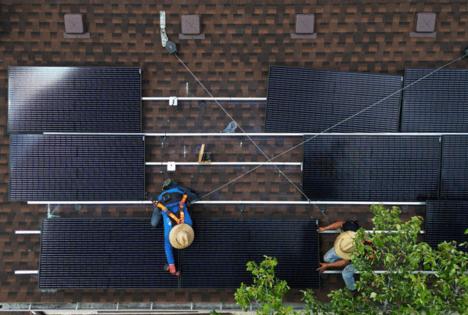Illinois clean energy hit hard by Trump's 'big, beautiful' tax bill: 'An incredibly damaging blow'
Published in News & Features
CHICAGO — Already the calls are coming in at Chicago’s All Bright Solar.
Customers want solar roofs installed on their homes — and they want them before a federal tax credit worth about $8,000 expires at the end of the year.
The repeal of that tax credit under President Donald Trump’s “One Big Beautiful Bill” is “pretty catastrophic” for residential solar, according to All Bright owner Lisa Albrecht, who expects demand to fall sharply.
“I’ve been on the ‘solar-coaster’ for a long time, and this is the roughest ride,” said Albrecht, using a term for the dramatic highs and lows of the industry. “I’m definitely white-knuckling it. (Illinois) will lose jobs. We will lose installers.”
Residential solar is particularly hard hit, but the president’s far-reaching budget bill, signed July 4, has dealt a mighty blow to Illinois’ clean energy overall, ending a tax credit of up to $7,500 for electric vehicle buyers, reducing access to tax credits for battery and solar panel manufacturers, slowing the construction of wind and solar farms and leaving $14 billion of announced clean energy investment statewide at higher risk for cancelation or downsizing.
Under the bill, Illinois will see about 30% to 60% less clean power added to the grid by 2035, according to an analysis of a similar scenario by the Rhodium Group, a financial research firm.
The firm also found that there would be about 16% to 38% fewer electric vehicles on the road nationwide in 2035.
“This bill goes after the very foundation of a clean energy economy, and tips the scales toward fossil fuels instead. So it is an incredibly damaging blow to the clean energy transition … it will severely curtail deployment,” said Julie McNamara, the associate policy director for climate and energy at the Union of Concerned Scientists.
Still, she said, clean energy deployment will continue: “It will just come slower than it could and should have, and at higher cost.”
The bill comes at a time of growing concern about climate change, which is caused mainly by the burning of fossil fuels and increases the likelihood of extreme weather events such as severe floods, multiyear droughts, record-breaking heat waves and raging wildfires.
Illinois clean energy supporters bemoaned what’s essentially the rollback of President Joe Biden’s landmark climate bill, the Inflation Reduction Act, which Trump has labeled the “green new scam” and targeted from the first days of his administration.
But even as they were licking their wounds, the state’s clean energy advocates were looking to the future.
Clean energy companies, environmentalists and trade associations are all now very focused on what can be done on a state level, said Jon Carson, founder and managing partner at Trajectory Energy Partners, a solar development company in Highland Park.
“It’s very clear to me that this will only amplify Illinois’ leadership role in driving clean energy forward,” he said.
Environmentalists and the clean energy industry had already been pushing for a new Illinois clean energy law, with provisions such as an ambitious new goal for large-scale energy storage, in which giant batteries absorb wind and solar energy when it’s not needed, and release it when it is.
Trump, a strong supporter of fossil fuels, has pressed for the repeal of Biden’s climate bill on the grounds that it unfairly favored some forms of energy over others.
“For too long, the Federal Government has forced American taxpayers to subsidize expensive and unreliable energy sources like wind and solar,” Trump said in a July 7 executive order on the implementation of the One Big Beautiful Bill. “… Ending the massive cost of taxpayer handouts to unreliable energy sources is vital to energy dominance, national security, economic growth, and the fiscal health of the Nation.”
Large solar farms and onshore wind are the most cost-effective forms of new-build energy generation, even without tax subsidies, according to a 2025 report from the financial firm Lazard.
Wind and solar farms don’t run as constantly as gas or coal plants, but solutions such as battery storage can help produce a steadier and more predictable flow of electricity.
In the aftermath of the Trump bill, Illinois clean energy has an advantage; it still benefits from the state’s own ambitious climate law, the 2021 Climate and Equitable Jobs Act, a signature achievement for Gov. JB Pritzker. The law sets a goal of 100% carbon-free electricity by 2045.
Illinois has annual targets for wind and solar energy, and requires the utilities ComEd, Ameren Illinois and MidAmerican Energy to purchase increasing amounts of clean electricity. The state has an incentive for residential solar customers that’s worth nearly as much as the federal tax credit. And there’s a state rebate for electric vehicles of up to $4,000.
Illinois is expected to see a smaller reduction in new clean energy under the Trump bill than the nation as a whole, according to the Rhodium Group. The 30% to 60% less clean power that will be added here by 2035 compares with 57% to 72% less nationwide, according to Ben King, a director in the firm’s climate and energy practice.
“Part of that is just that Illinois is a great place to build wind, particularly downstate, and the economics of that are favorable in some cases, even without the tax credits,” King said.
But he added that Illinois’ clean energy policies also provide “guardrails” that protect the state from some of the impact of the Trump bill.
The Trump bill is expected to increase planet-warming greenhouse gas emissions, according to an analysis by Princeton’s REPEAT project, which found the U.S. would emit roughly 470 million additional metric tons per year in 2035.
For comparison, 470 million metric tons is more than twice Illinois’ current annual greenhouse gas emissions.
The bill is also expected to cost Illinois jobs, with 21,000 fewer people employed in 2030, according to Dan O’Brien, a senior analyst at Energy Innovation, a nonpartisan energy and climate policy think tank.
With the bill in place, the annual energy cost per household nationwide will be $170 higher in 2035, according to the think tank.
“We (will) lose a lot of low-cost renewables that are pushing prices down for household consumers as well as commercial businesses and industries,” O’Brien said. “So as a result of the bill, we’re likely to see pretty steep increases in the costs for people like you and me.”
King noted that $14 billion in clean energy investments — for manufacturing and utility-scale wind and solar — have been announced in Illinois but have not yet come online.
“A lot of that investment has been put at risk because of the changes in this bill,” he said.
Among those who want to respond to the Trump bill with strong state action is Jen Walling, executive director of the Illinois Environmental Council, which advocates for more than 100 organizations.
Illinois environmentalists have been pushing for the Clean and Reliable Grid Affordability Act, which would expand energy efficiency in Illinois and encourage renewable energy projects.
Walling said she wants the state to prioritize the addition of new transmission — the system, including high-voltage wires, that carries electricity across long distances. With more transmission, it’s faster and easier to add solar and wind projects to the electric grid.
Large battery arrays, which store energy from wind and solar farms and help make them more efficient, are also a priority, she said.
The Illinois legislature made progress on a wide-ranging clean energy bill in the spring, and Walling would like to see that work continue when lawmakers return in the fall.
“We have a big, beautiful bill that we need to get done,” she said.
____
©2025 Chicago Tribune. Visit at chicagotribune.com. Distributed by Tribune Content Agency, LLC.







Comments